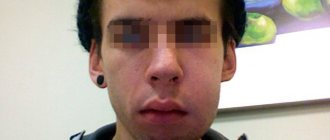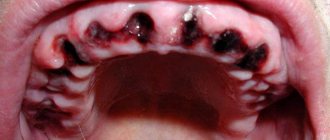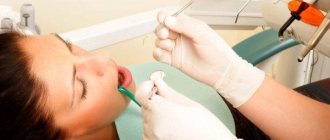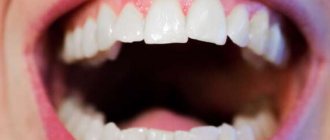Today, anesthesia in dentistry is used everywhere for a variety of procedures, from hygienic cleaning to implantation. An anesthetic injection not only provides comfort to the patient, but also significantly facilitates the doctor’s work.
Read in this article:
- How long does tooth freezing last?
- Treatment and removal - is there a difference in pain relief?
- How long does dental anesthesia last?
- What to do to make dental anesthesia go faster
- 4 tips on how to “freeze off” faster
- What to do if numbness of teeth does not go away after anesthesia
- What's the result?
The anesthetic technique is selected taking into account the type of manipulation and implies a certain exposure time. After administration of the drug, the tissues surrounding the tooth are “frozen” and stop responding to any irritants. Sometimes this lasts much longer than necessary and does not allow you to return to your usual rhythm.
Treatment and removal - is there a difference in pain relief?
There are 3 types of anesthesia most commonly used:
- application;
- infiltration;
- conductor.
Freezing during tooth extraction is mainly conductive, since it turns off large nerve trunks and lasts longer, about several hours. Teeth are treated primarily with infiltration anesthesia, the effect of which lasts from 15 minutes to 1 hour.
Applications are used to perform small procedures, often in children. Local application of Lidocaine 10% can only numb the injection site. Therefore, it can hardly be called freezing.
The type of anesthesia is determined based on which area needs to be numbed. For example, freezing when treating teeth on the upper jaw and in the area of the lower incisors is usually infiltrative: an injection is made into the transitional fold area of the diseased tooth.
Attention!
Infiltration anesthesia can also be used when removing upper or lower anterior teeth. Therefore, sensitivity in these places usually returns faster.
The transitional fold is located on the border of the lower part of the gum and the mobile mucous membrane of the cheek or lip. After administration of the medicine, an infiltrate is formed here - a kind of depot, from which the anesthetic quickly spreads to the jaw bone.
As for conduction anesthesia, it is used not only for removal, but also for treatment, especially of molars. This is due to the properties of the structure of the mandibular bone - it is more dense and voluminous. Moreover, the density and dimensions increase closer to the corners of the jaw.
Medicines that are most often used in the dental office
If you need to numb a tooth, the doctor may use different drugs. The list of the most popular includes:
- Novocaine. Has a short period of action.
- Lidocaine and products containing articaine. Provides a medium-duration analgesic effect.
- Bupivacaine, Hirocaine, Ropivacaine. They have a long period of action.
The doctor determines which drug to choose taking into account the complexity of the upcoming treatment procedures. It is important that the patient is not allergic to the prescribed anesthetic.
How long does dental anesthesia last?
On average, the freezing effect lasts 1-2 hours. However, its duration depends on the drug used: for example, injections with Novocaine anesthetize for no more than half an hour, Bupivacaine acts for at least 2 hours. Modern clinics mainly use anesthetics containing Articaine, which freezes tissue for up to 3 hours.
The infiltration anesthesia on the upper jaw will wear off in 45 minutes at most. This is due to the structure of the maxillary bone, which is looser and better supplied with blood.
Freezing after tooth extraction will last longer if the anesthetic contains a vasoconstrictor - a substance that constricts blood vessels and prolongs pain relief.
Complications after sedation
Do nausea and fainting occur after sedation, or can such nuances be clarified before it begins? Of course, the characteristics of patients may be different: for some it may be nausea, for others it may be dizziness, etc. All this, of course, is discussed in advance in consultation with an anesthesiologist-resuscitator. It determines the patient’s health characteristics and determines the reactions that are possible due to the action of the drug. Any sedative drug can cause:
- drowsiness throughout the day after the manipulation, especially if the treatment was carried out in the morning,
- weakness,
- mild nausea
- It may make some people feel hungry, while others may feel the opposite.
There may be peculiarities, and this is not something pathological or something negative, this is the norm.
What to do if numbness of teeth does not go away after anesthesia
Lack of sensitivity can last for quite a long time, especially after the removal of difficult wisdom teeth. Sometimes you have to wait 8 or even 9 hours for “defrosting”.
If all the normal deadlines have passed, and the numbness of the gums, tongue or nose does not go away, you should consult a dentist. It is possible that during the manipulations the nerve that is responsible for the innervation of the mucous membranes of the nose or tongue was damaged.
This happens when extracting figure eights with roots that come close to the mandibular nerve trunk. Fortunately, this situation is very rare, occurring in only 0.5% of patients.
But even if you fall into this half a percent, it is fixable. Over time, the nerve recovers and sensitivity returns. The bad news is that sometimes the recovery process takes several months (but no more than six months), and it is impossible to speed it up.
Make an appointment for lower wisdom tooth removal
Byshlyaga Dmitry Yurievich
Byshlyaga Dmitry Yurievich Orthopedic dentist
Extensive practical experience. Regularly undergoes internships and advanced training courses.
Working hours: from 9.00 to 20.00, daily, seven days a week, by appointment
Make an appointment
More details
Asatryan Alexander Aramovich
Asatryan Alexander Aramovich Dentist therapist - orthopedist - surgeon
Extensive practical experience. Regularly undergoes internships and advanced training courses.
Working hours: from 9.00 to 20.00, daily, seven days a week, by appointment
Make an appointment
More details
×
Children
It should be noted separately the features of local anesthesia in children. The technique of local anesthesia in children must be planned so that 100% pain relief is achieved at all stages of treatment, otherwise it will be impossible to carry out the necessary manipulations.
As mentioned above, children under 5 years of age are given an anesthetic without adrenaline (3% scandonest SVC, or septanest 4% SVC).
Children over 5 years old can use an anesthetic with low concentration adrenaline (1:200,000 - Ultracaine DS). The dose of drugs is selected depending on age. Pain relief is performed in children in 3 stages:
- First, a superficial anesthetic gel is applied
- then a small dose (0.1-0.2 ml) of anesthetic is administered;
- after which, after 60-90 seconds (time sufficient for effective anesthesia of the needle path in the soft tissues), the remaining amount of the planned dose of anesthetic is administered.
We wait 5-10 minutes until complete anesthesia occurs. The child, feeling a complete absence of pain, gains confidence in the doctor and gives the opportunity to carry out the necessary intervention.
The use of anesthesia for health pathologies
- diabetes mellitus, bronchial asthma, allergic reactions: anesthetics without preservatives and with a minimal amount of epinephrine are used. For these problems, medications are selected strictly individually, most often based on the results of additional tests,
- high blood pressure, heart disease: with minimal or no epinephrine. It is also important that anesthetics do not contain adrenaline. For these pathologies, intravenous or xenon sedation can be used,
- pregnancy and lactation: drugs with a low content of epinephrine - in minimal dosages, the active substance does not cross the placenta and practically does not enter breast milk (only in small quantities, but this does not have any negative effect, so after dental treatment you can not skip feeding and no need to express milk). It is important that the drugs cannot be used without the addition of the vasoconstrictor epinephrine - in this case, the vessels remain open and the active substance will quickly spread throughout the body, which increases the risk of its transmission to the fetus or child through breast milk.
Other methods
Other methods of anesthesia are also used in dentistry - these are non-drug methods of pain relief.
Currently, anesthesia is performed using the following method:
- computer anesthesia - the anesthetic is administered, and the process is controlled by a computer;
- hypnosis – through hypnotic influence, superficial anesthesia occurs;
- alektroanalgesia – high-frequency electrical impulses affect specific centers of the cerebral cortex;
- Audio analgesia is a psychotropic, a kind of distracting drug.
Example of drug administration
The doctor tells the patient in advance how long tooth freezing lasts. As a rule, it all depends on what type of anesthesia was used.
If the doctor has placed a temporary filling
A temporary filling is made of a fragile material and is placed for several days to close the tooth cavity with the medicine placed inside. The patient’s task is not to damage the temporary filling until the next visit to the dentist:
- teeth are brushed with care; the pressure of the toothbrush on the tooth on which the temporary filling is placed should be minimal;
- It is better to exclude very hot and very cold foods and drinks. You cannot eat hot and cold at the same time;
- The chewing load on the filled tooth should be limited; it is better not to chew food with it, if possible.
Xenon sedation or xenon therapy to prepare for main anesthesia
This is a separate type of anesthesia that can be used in combination with both local and general anesthesia (if necessary). Xenon is an inert gas that quickly begins to act and is just as quickly eliminated from the body. It has a relaxing effect: anxiety decreases, the patient relaxes. Moreover, during the operation he is fully conscious, can communicate with the doctor, and understands everything that is happening around him. The procedure can be interrupted if necessary if there is discomfort. At the same time, local anesthetics are used, since xenon itself does not have a pronounced analgesic effect.
Among the pleasant “bonuses” are saturation of cells with oxygen and restoration of metabolic processes. That is, this is not only a reduction in stress, but also a general improvement in the body’s health.
Features and types of anesthetics
All medications are divided according to how long they last. There are short-acting, long-acting or medium-acting remedies. In district clinics, older generation drugs are often used, for example, novocaine or lidocaine.
Novocaine is used for anesthesia
Modern drugs are used in private offices and clinics. They are produced in capsules - reservoirs into which a syringe is inserted. Such injections are painless, and all thanks to the fact that the needle is thin.
In addition, the drug does not come into contact with air, which means everything happens in complete sterility. Another plus is the exact dosage. New anesthetics used in such institutions are melivacaine and articaine.
Articaine series
Articaine is a new and frequently used remedy in private clinics. It is produced under many names and contains many substances, so you can select the right remedy for different patients.
It is customary to supplement Articaine with norepinephrine or adrenaline, after which the drug begins to have vasoconstrictor properties. Excess blood loss is eliminated, and the patient experiences minimal discomfort.
Modern medicine
Compared to lidocaine or novocaine, Articaine is several times more effective. With the correct dosage, it is possible to treat even those patients who have endocrine problems, as well as pregnant women and nursing mothers.
Mepivacaines
Drugs from this series are produced under different names, the most famous drug is Scandonest. Adrenaline is used as a supplement, which is why the effectiveness is slightly less than that of articaine.
The substance mepivacaine has a unique property - it narrows blood vessels. More often used to treat pregnant women, heart patients, and children.











